In early 2025, a small coffee roastery in Portland quietly integrated a machine learning (ML) algorithm to predict peak demand hours. What started as a modest tech experiment soon cut their weekly waste by 22% and boosted sales by automating batch sizes based on weather, local events, and past orders. This is just one of countless stories showcasing the ever-growing reach of machine learning.
Machine learning is no longer confined to academic labs or tech giants. In 2025, it’s embedded in daily decisions, from small business operations to global logistics and personalized medicine. This article explores the current statistics shaping the landscape of ML and provides actionable insights into how it’s evolving.
Editor’s Choice
- 64% of all U.S. companies reported using some form of machine learning in 2025.
- 42% of SMBs (small and medium businesses) in the U.S. adopted at least one ML solution this year, a 10% increase YoY.
- The global ML market value reached an estimated $217 billion in 2025, nearly doubling its 2022 valuation of $107 billion.
- Python continues to dominate ML programming, used in over 92% of ML projects globally.
- Healthcare and finance lead ML adoption by domain, accounting for 28% and 21% of total use cases, respectively.
- ML-backed features in consumer tech (voice assistants, smart recommendations) saw 37% YoY growth in 2025.
- Energy consumption of large language models has dropped by 14% on average per training cycle compared to 2024, thanks to optimization techniques like quantization.
Top Use Cases of Machine Learning
- Reducing costs tops the chart, with 38% of businesses leveraging ML to cut expenses.
- Customer insights come next at 37%, helping brands make smarter, data-driven decisions.
- 34% are using ML to enhance the customer experience through better personalization.
- 30% apply ML to automate internal processes, improving overall efficiency.
- 29% focus on customer retention through predictive analytics and early churn signals.
- 28% rely on ML for customer interactions, such as chatbots and automated support.
- Recommender systems and fraud detection are each used by 27% of businesses.
- 26% use ML to reduce churn, acquire customers, and boost satisfaction.
- 25% deploy ML to predict demand shifts, helping with inventory and logistics.
- 20% integrate ML into loyalty programs, enhancing repeat engagement.
- 19% aim to strengthen long-term engagement through advanced ML strategies.
- 17% turn to ML for conversion rate optimization using predictive models.
- 14% use ML for content filtering and brand awareness campaigns.
- 15% cited other innovative applications beyond the usual use cases.
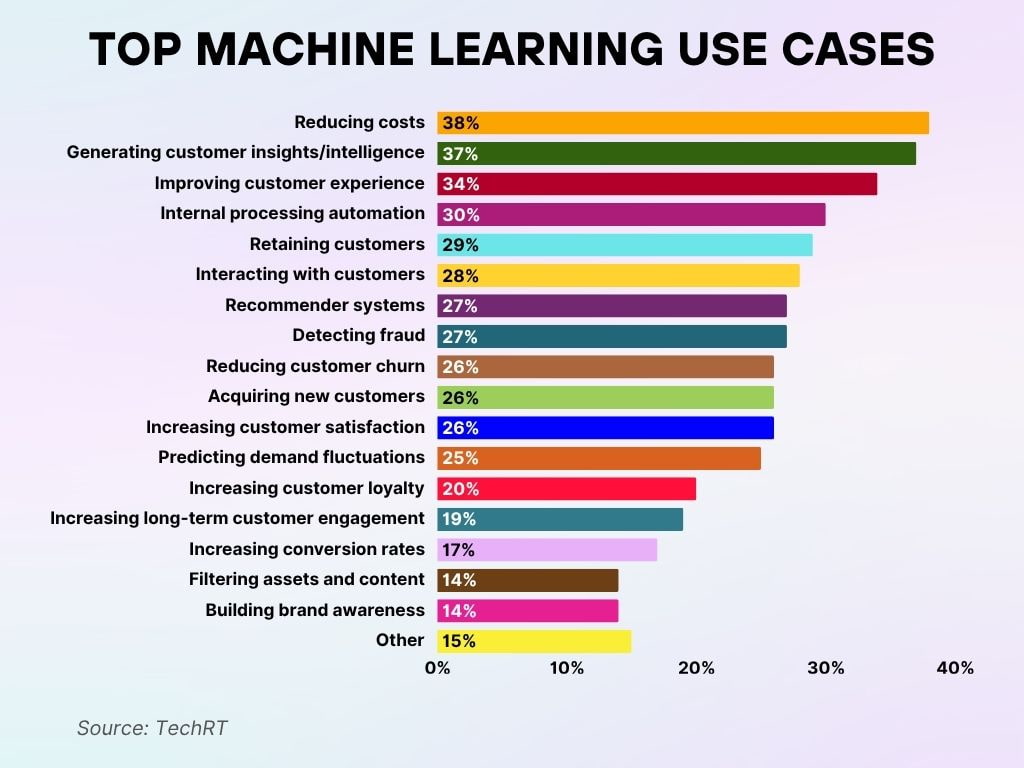
Machine Learning Adoption Among Small and Medium Enterprises
- In 2025, 42% of SMBs in the U.S. are actively using ML, with a strong uptick in industries like retail, logistics, and agriculture.
- 27% of SMBs reported using ML for predictive analytics to improve demand forecasting.
- 19% of small manufacturers have deployed ML for quality control and predictive maintenance.
- Cloud ML services like Amazon SageMaker, Google Cloud Vertex AI, and Microsoft Azure ML are used by over 58% of SMB ML adopters.
- The cost barrier to ML implementation has dropped by 35% since 2022 due to open-source tools and pre-trained models.
- Among SMBs with under 100 employees, 12% now employ dedicated data scientists or ML engineers.
- Marketing automation powered by ML is the most common use case among SMBs in 2025, cited by 31% of adopters.
- Companies using ML tools report an average of 16% higher customer retention rates compared to non-users.
Machine Learning Software Market Share Breakdown
- Newsle leads the pack with a commanding 88.86% market share, an overwhelming dominance.
- TensorFlow, while popular in name, holds just 3.28% of the market.
- Torch captures a smaller slice at 2.74%, yet still maintains a niche following.
- All other platforms combined account for only 5.12%, signaling a highly concentrated market.
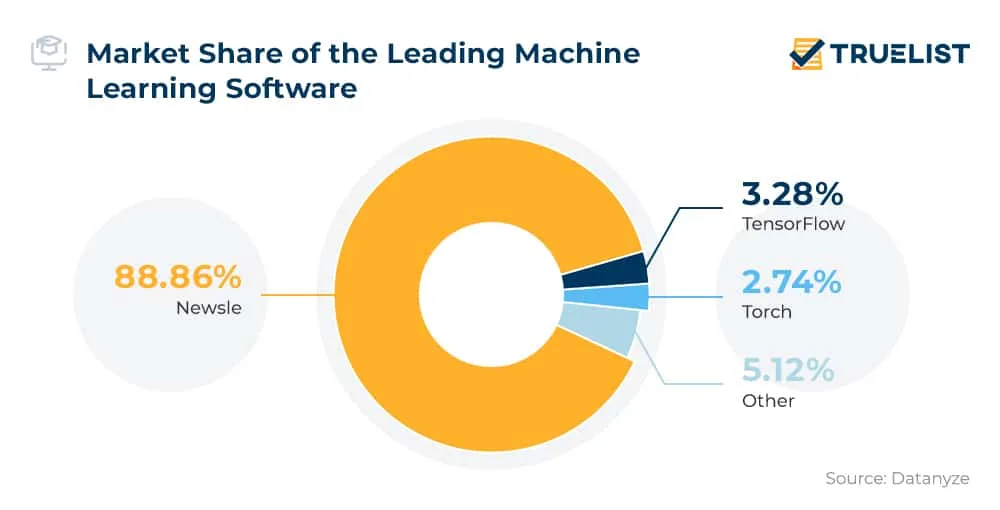
Top Programming Languages Used in Machine Learning Projects
- Python remains the top language for ML in 2025, used by over 92% of practitioners for its extensive libraries like TensorFlow, PyTorch, and Scikit-learn.
- R sees steady niche use, particularly in academia and bioinformatics, holding about 6% share of the ML programming ecosystem.
- Julia continues to gain traction for performance-heavy ML tasks, especially in finance and energy sectors, with 3.2% adoption.
- JavaScript-based ML frameworks like TensorFlow.js are being explored in browser-native models, now used in 2% of lightweight applications.
- Rust and Go are emerging for deployment-heavy ML pipelines due to their speed and memory safety, now used in about 1.5% of enterprise ML projects.
- MATLAB, while declining in popularity, still maintains usage in legacy systems and aerospace applications.
- Hybrid languages and polyglot systems are used in 11% of large-scale ML deployments, integrating Python with C++ or Java for performance optimization.
Distribution of Machine Learning Applications by Domain
- Healthcare leads ML application domains in 2025, accounting for 28% of all use cases, driven by diagnostics, drug discovery, and patient risk modeling.
- Finance and insurance follow closely at 21%, leveraging ML for fraud detection, credit scoring, and algorithmic trading.
- Retail and e-commerce account for 16%, primarily in recommendation engines, inventory optimization, and dynamic pricing.
- Manufacturing represents 12% of use cases, where ML supports predictive maintenance and supply chain optimization.
- Logistics and transportation make up 9%, using ML in route optimization and autonomous systems.
- Education and HR tech combined contribute 8%, focused on adaptive learning and resume screening.
- Energy and utilities see 4% ML usage, especially in grid forecasting and demand prediction.
- Government and public services adoption remains low at 2%, though smart city pilot projects are on the rise.
Industries Leading the Way in Machine Learning Adoption
- IT and Telecommunications are out front, with 19% adoption, driving innovation across networks and infrastructure.
- Banking, Financial Services, and Insurance follow at 18%, tapping into ML for fraud detection, risk management, and process automation.
- Automotive and Transport make up 14%, using ML in autonomous tech and logistics optimization.
- Both Healthcare and Retail are tied at 12%, applying ML in diagnostics, personalized care, and inventory planning.
- Manufacturing holds a 10% share, focusing on predictive maintenance and quality control.
- Advertising and Media use ML in 9% of operations to sharpen ad targeting and content strategy.
- All other sectors account for the remaining 8%, showing ML’s expanding footprint across industries.
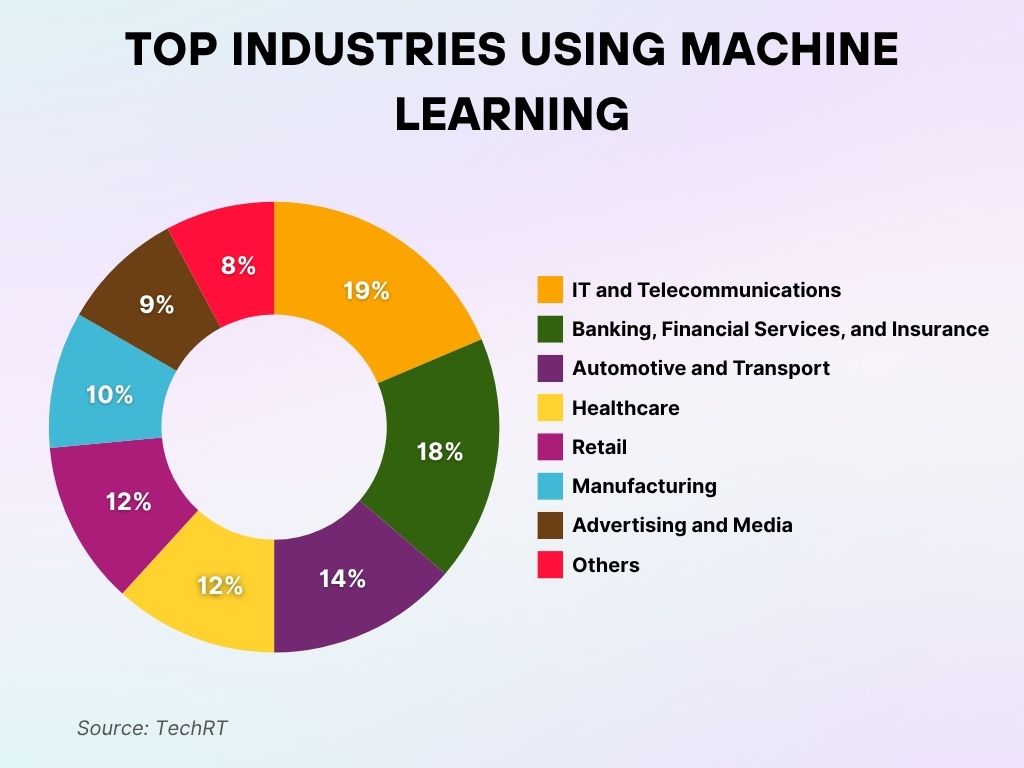
Trends in ML-Powered Product Features
- In 2025, machine learning-driven personalization features will be used by 71% of consumer platforms, from streaming to shopping apps.
- Smart assistants like Alexa, Siri, and Google Assistant have integrated over 30 new contextual ML models to improve natural language interaction.
- ML-enabled real-time fraud detection tools now protect over 82% of online payment transactions.
- Voice and image recognition features in mobile apps increased by 21% YoY, becoming standard in e-commerce and banking apps.
- Autocorrect and predictive typing ML models now support 140+ languages, improving accessibility worldwide.
- ML-based video content tagging tools are used by over 67% of media and ad tech companies to improve search and ad placement.
- Behavioral analytics powered by ML is used in 45% of SaaS products to optimize user flows and engagement.
- Real-time AI-driven customer support via chatbots and virtual agents now handles 40% of Tier 1 queries globally.
- ML-enhanced cybersecurity monitoring tools are deployed in 33% of enterprise environments, helping to identify zero-day threats.
- The average feature release cycle for ML-backed software is now 18% faster, thanks to automated testing and ML-assisted code reviews.
Energy Consumption of ML Models
- In 2025, training a large-scale language model (LLM) consumes about 1.2 GWh.
- Energy efficiency improvements, including sparsity techniques and model distillation, reduced training costs by 15% on average.
- Data centers optimized for ML workloads reported 26% less power consumption per inference task.
- Edge ML models, used in IoT and mobile devices, now support real-time inference under 2W, making them viable for battery-powered devices.
- Green AI initiatives are adopted by 49% of Fortune 500 companies, pushing for sustainability in AI development.
- ML model compression techniques like pruning and quantization are used in 67% of production environments to lower energy impact.
- Federated learning architectures are gaining traction with 18% adoption, offering decentralized training with reduced data movement.
- The use of renewable-powered compute farms for ML training grew to 33% in 2025.
Biggest Challenges in Adopting Machine Learning
- Scaling ML efforts is the top challenge, reported by 43% of organizations, and turning pilot projects into full-scale deployment isn’t easy.
- 41% struggle with versioning and reproducibility, making it tough to maintain consistency across ML models.
- Organizational alignment and lack of executive support hinder adoption for 34%, slowing momentum.
- 33% face friction with multi-language and framework support, complicating integration into existing systems.
- 28% deal with duplicate efforts across teams, leading to wasted time and misaligned priorities.
- 26% fall under “Other” challenges, showing a wide range of unique hurdles in the ML adoption journey.
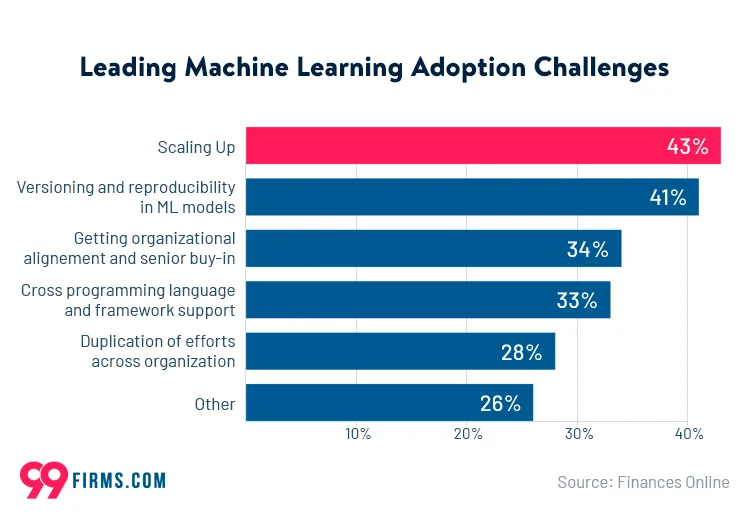
Impact of ML on Operational Efficiency Metrics
- Businesses integrating ML report an average productivity increase of 21% in 2025 across key departments.
- Predictive analytics has helped reduce inventory waste by up to 29% in retail and manufacturing.
- Automated ML-driven scheduling systems cut down staff overtime hours by 12% across logistics companies.
- Customer support automation has improved ticket resolution speed by 31% for B2C firms.
- ML has enhanced forecast accuracy by 35% in finance and 28% in healthcare over traditional methods.
- Companies using ML to analyze customer churn indicators report an average churn reduction of 19%.
- Document automation through NLP models saved an estimated 2.3 billion work hours globally in 2025.
- Robotic process automation (RPA), powered by ML, increased task execution speed by 40% on average in enterprise environments.
Machine Learning Patent Filing
- In 2025, the United States Patent and Trademark Office (USPTO) recorded over 22,000 ML-related patent filings.
- China led global ML patent applications, filing over 38,000 patents, maintaining its top spot since 2021.
- The EU bloc filed around 9,300 ML patents, focusing heavily on healthcare and autonomous systems.
- Japan saw a modest rise in filings, with 4,200 ML patents, especially in robotics and manufacturing.
- Top ML patent filers include Google, IBM, Microsoft, Tencent, and Samsung.
- Over 58% of all ML patents in 2025 relate to deep learning, especially in NLP and computer vision.
- Cross-disciplinary patents, combining ML with quantum computing or biotechnology, accounted for 12% of new filings.
- Patent applications focusing on model interpretability and explainability have grown by 19% YoY, reflecting regulatory trends.
Global Machine Learning Market Distribution
- Europe leads the charge with a commanding 44.9% of the global ML market, currently the top regional player.
- North America is right behind at 44.1%, showing near-equal dominance in driving ML innovation.
- Asia-Pacific (APAC) holds 11.1%, marking it as a rising force in the global machine learning space.
- Together, Europe and North America control nearly 89% of the world’s ML market, a clear duopoly in the space.
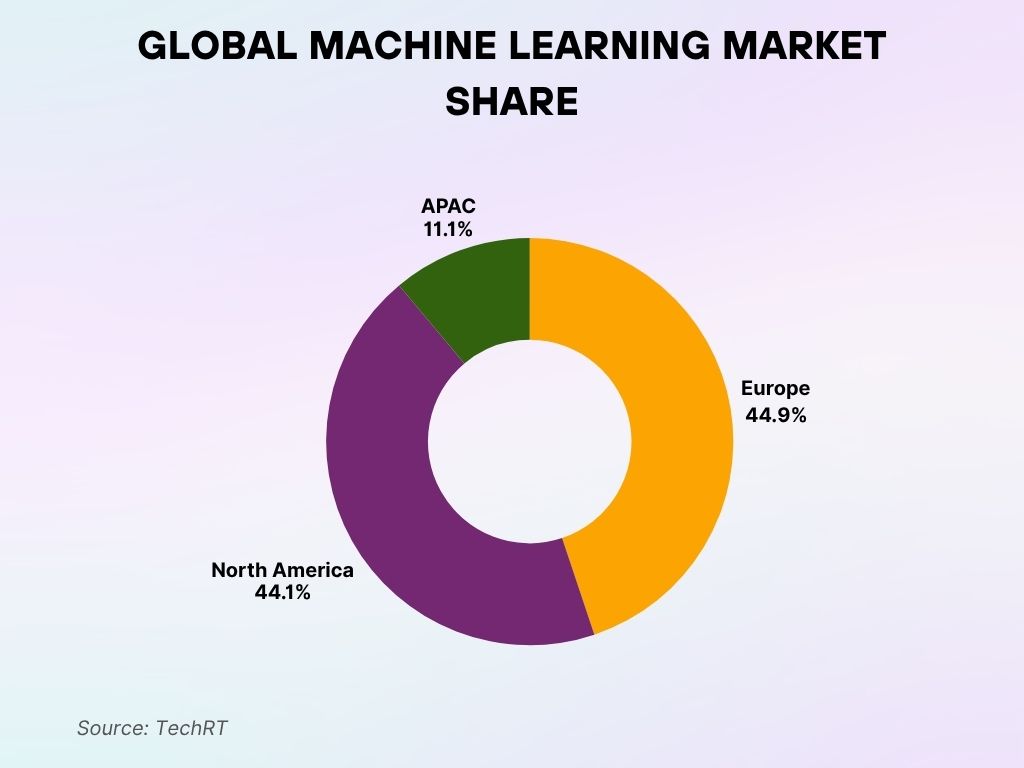
Open Source vs Proprietary ML Framework Usage
- Open-source ML frameworks dominate in 2025, with TensorFlow (29%), PyTorch (43%), and Scikit-learn (15%) leading the pack.
- Proprietary ML platforms like SAS Viya, DataRobot, and IBM Watson collectively hold 13% market share.
- PyTorch adoption surpassed TensorFlow in 2023 and maintains a strong lead due to developer-friendly APIs and academic support.
- JAX and Hugging Face Transformers usage grew by 11% YoY, especially for LLM fine-tuning.
- Proprietary ML services are preferred by regulated industries like banking and healthcare due to their audit-friendly features.
- Open-source contributions to ML libraries increased by 26% YoY, driven by academic and startup ecosystems.
- Hybrid approaches using open-source frameworks with proprietary enhancements now power 21% of enterprise ML deployments.
- Developers cite community support and transparency as top reasons for favoring open-source over vendor-locked solutions.
Educational Trends in ML and Data Science Enrollment
- In 2025, enrollment in machine learning and data science programs in the U.S. surpassed 410,000 students.
- Community colleges now offer ML certifications in over 38 states, making up 17% of total new ML student intakes.
- Graduate-level ML programs saw an 18% increase in applications across top U.S. universities.
- Online ML courses on platforms like Coursera, Udacity, and edX recorded over 15 million active learners worldwide this year.
- Women’s participation in ML education reached a record 34%.
- The demand for ML bootcamps and nano-degree programs grew by 22%, especially among career changers and non-STEM professionals.
- High school-level AI curriculum pilots were launched in 11 U.S. states, aiming to introduce ML basics earlier.
- Top skills students aimed to master included deep learning, reinforcement learning, and ML ops pipelines in production.
- A survey showed that 71% of graduates with ML degrees in 2025 received job offers within 3 months of graduation.
- Interdisciplinary ML programs combining ethics, public policy, and healthcare analytics now exist in over 25 major universities.
AI/ML Medical Device Market – Growth Outlook
- The global market is set to surge from $6.63 billion in 2024 to $21.07 billion by 2029, a massive jump in just five years.
- With a CAGR of 26.7%, the sector is on a path of explosive and steady expansion.
- In 2025, the market is expected to hit $8.17 billion, showing strong year-over-year momentum.
- 2026 and beyond will continue the upward trend, with forecasts showing accelerated growth, even if exact figures aren’t specified.
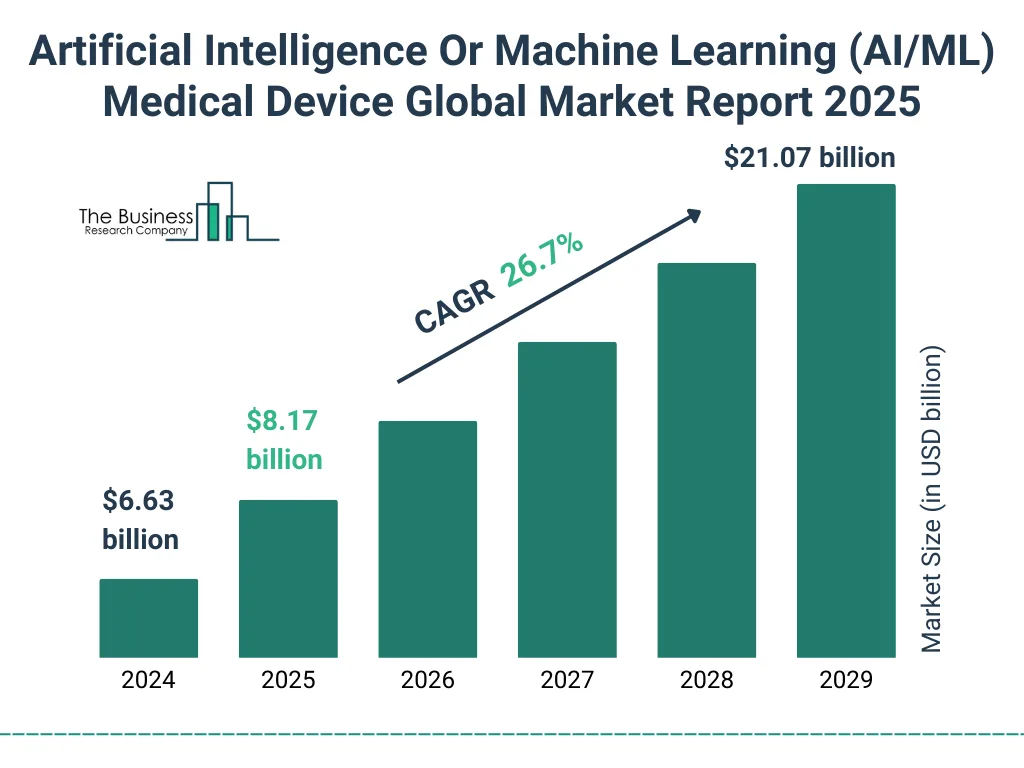
ML Integration with IoT: Adoption and Performance
- In 2025, ML-enabled IoT solutions reached 980 million active deployments.
- Smart home devices embedded with ML algorithms now represent 65% of the global market share.
- Predictive maintenance systems in industrial IoT (IIoT) report reducing equipment failure by 36% on average.
- Edge ML deployments on IoT devices saw a 29% rise, allowing real-time inference without cloud reliance.
- Smart agriculture applications using ML + IoT helped increase crop yields by an estimated 17% in pilot regions.
- ML-powered smart city initiatives (e.g., adaptive traffic lights, environmental sensors) expanded to 39 countries.
- Healthcare IoT devices, including wearable monitors, now use ML for anomaly detection in real time, improving early diagnostics.
- Energy-efficient ML chips are now embedded in 23% of new IoT devices, extending battery life by 15–20%.
- The most common use cases for ML in IoT in 2025 include predictive analytics, anomaly detection, and dynamic routing.
Regional Trends in Machine Learning Deployment
- North America leads in ML adoption with 39% of global ML workloads, driven by enterprise use and cloud infrastructure.
- Asia-Pacific (APAC) follows closely at 33%, with China, India, and South Korea investing heavily in AI research and deployment.
- Europe accounts for 21% of global ML activity, focusing on ethical AI and regulatory alignment with the GDPR and AI Act frameworks.
- Latin America and Africa are emerging regions, representing 7% of global deployments, primarily in finance and agriculture.
- China surpassed the U.S. in AI research paper submissions for the third consecutive year.
- In 2025, Singapore became the top ML deployment hub per capita, due to its nationwide AI strategy and startup incentives.
- Brazil and Nigeria are among the fastest-growing countries for ML application in fintech and telemedicine.
- Regional regulations, such as the EU’s AI Act, are influencing the pace and style of ML deployment across continents.
- Government-backed ML projects are most prominent in India, Canada, the UAE, and Germany in 2025.
- Cross-border ML collaboration projects, especially in climate modeling and genomics, are gaining traction under UN-backed initiatives.
Recent Developments in Machine Learning
- In early 2025, OpenAI’s GPT-5 became the first model to surpass human performance in certain legal comprehension tasks.
- Meta’s Chameleon architecture, blending transformers and diffusion models, made real-time video generation viable on consumer devices.
- Google DeepMind’s AlphaFold 3 now predicts protein interactions across multi-chain complexes, aiding rare disease research.
- ML interoperability standards were formalized by IEEE to streamline cross-platform model deployment.
- The rise of agentic AI systems, capable of autonomous multi-step decision-making, became a hot R&D focus.
- TinyML frameworks like Edge Impulse and TensorFlow Lite Micro became standard for wearable tech and embedded ML.
- ML models trained on synthetic data are being used in 27% of new projects to overcome data privacy barriers.
- Explainable AI (XAI) frameworks gained momentum, with new models offering transparency for over 90% of predictions.
- ML fairness audits are now mandatory in 8 U.S. states for public-facing algorithms, setting new compliance standards.
- AI copyright and IP rights legislation was proposed in both the U.S. and the EU to clarify ML-generated content ownership.
Conclusion
Machine learning in 2025 is not just progressing, it’s integrating, democratizing, and redefining how we live and work. From small businesses leveraging affordable ML tools to governments setting ethical deployment frameworks, the ecosystem is maturing rapidly. With growing awareness of energy impact and fairness, ML is no longer just about performance; it’s about responsible scalability. As educational and regional initiatives catch up, we can expect the next wave of innovation to be more inclusive, efficient, and human-centered.


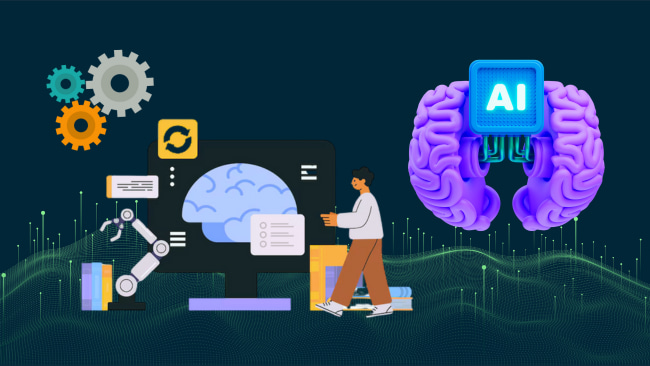
Leave a comment
Have something to say about this article? Add your comment and start the discussion.